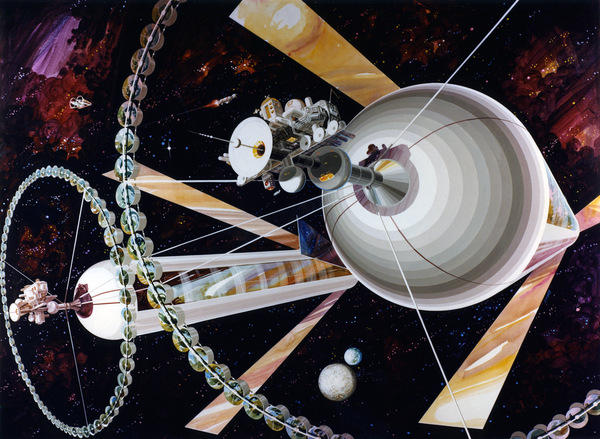This article explores: The economic feasibility of O’Neill Cylinders for space tourism and industry. Find out more about The Economic Feasibility Of O’Neill Cylinders.

Space exploration and development have always been fascinating topics for science and technology enthusiasts. The idea of establishing human settlements outside of our planet has been a long-standing dream for many.
Recently, the concept of space tourism has gained a lot of attention, and several private companies are investing in it. However, the cost of space tourism is still too high for the general public to afford.
To make space tourism more accessible and economically feasible, the concept of O’Neill Cylinders has been proposed. O’Neill Cylinders are massive, rotating structures capable of accommodating thousands of people and creating a self-sustaining ecosystem in space.
This paper aims to explore the economic feasibility of O’Neill Cylinders for space tourism and industry. We will examine the potential benefits, costs, and challenges of building and maintaining these structures and assess whether they can be a profitable investment for private companies and government agencies.
How Much Would An O Neill Cylinder Cost?
It’s difficult to estimate the exact cost of building an O’Neill Cylinder as it would depend on many factors, such as the size of the cylinder, the materials used, and the level of technology available at the time of construction.
However, it’s safe to assume that building such a massive space habitat would be an extremely expensive endeavor, requiring significant financial investment and resources.
In 1976, Princeton physicist Gerard K. O’Neill estimated that it would cost around $3 trillion to build an O’Neill Cylinder capable of housing 1 million people.
This estimate was made nearly half a century ago and does not take into account the significant advances in technology and materials that have occurred since then. It’s likely that the cost of building an O’Neill Cylinder today would be significantly higher than this estimate.
Additionally, the cost of maintaining and operating an O’Neill Cylinder would be considerable. The habitat would require constant maintenance and repair, as well as the production of food, water, and oxygen for its inhabitants.
Despite the potential high costs, some proponents of space colonization see the development of O’Neill Cylinders as a worthwhile investment in the future of humanity’s expansion beyond Earth.
Design Concept Of The O’Neill Cylinder
The O’Neill Cylinder is a proposed design for a massive, rotating space habitat that could potentially sustain human life in outer space.
The concept was first proposed by physicist Gerard K. O’Neill in the 1970s and has since been refined by numerous space engineers and designers.
The O’Neill Cylinder consists of two large cylinders, each several miles long and rotating in opposite directions to create artificial gravity on their interior surfaces.
The cylinders are connected by a central hub that contains living quarters, communal spaces, and agricultural areas to provide food for the inhabitants. The habitat is designed to be self-sustaining, with renewable energy sources, such as solar panels, providing power for the entire system.
The interior of the O’Neill Cylinder would be divided into several distinct zones, including residential areas, commercial spaces, recreational areas, and agricultural zones. The habitat would be able to support a large population, potentially in the millions, with enough space for residents to live, work, and play comfortably.
One of the most important design considerations for the O’Neill Cylinder is creating an environment that is comfortable and healthy for its inhabitants. This includes ensuring adequate lighting, air quality, and temperature control, as well as providing ample space for physical activity and social interaction.
The habitat would also need to be designed to withstand the rigors of space, including exposure to radiation and micrometeoroids.
Overall, the design concept of the O’Neill Cylinder is focused on creating a sustainable and self-contained environment for long-term human habitation in space, with the ultimate goal of establishing a permanent human presence beyond Earth.
How Big Are The O Neill Cylinders?
The size of an O’Neill Cylinder can vary depending on the intended use and population capacity. However, the basic design typically consists of two massive cylinders, each several miles long and with a diameter of around 5 miles (8 kilometers).
The total length of the cylinders can range from 20 miles (32 kilometers) to over 30 miles (48 kilometers). The central hub connecting the two cylinders can also be several miles in diameter and include multiple levels for living quarters, agriculture, and other facilities.
Overall, the O’Neill Cylinder is designed to provide a large, rotating space habitat capable of sustaining a self-sufficient human population.
How To Calculate The Mass Of An O Neill Cylinder
Calculating the mass of an O’Neill Cylinder would depend on several factors such as its size, materials used for construction, and intended use.
Here’s a basic formula that can be used as a starting point:
Mass = Density x Volume
The volume of the cylinder can be calculated using the formula for the volume of a cylinder:
Volume = πr^2h
where r is the radius of the cylinder, and h is its height.
Once you have calculated the volume of the cylinder, you can multiply it by the density of the materials used for construction to determine the mass.
Keep in mind that the O’Neill Cylinder would require a variety of systems and components to support life, such as water and air filtration systems, artificial gravity generators, and power generation systems, which would also need to be factored into the overall mass calculations.
What Is Included In The Manufacture Of An O Neill Cylinder?
The manufacture of an O’Neill Cylinder would involve a variety of components and systems that would need to be designed, built, and assembled.
Some of the key components and systems that would be included in the manufacture of an O’Neill Cylinder are:
Outer shell:
The outer shell of the cylinder would need to be constructed from high-strength materials that can withstand the rigors of space travel and provide protection from radiation and micrometeoroids.
Structural supports:
The cylinder would require internal structural supports to maintain its shape and stability.
Atmosphere system:
The atmosphere inside the cylinder would need to be carefully managed to provide the necessary air pressure, composition, and humidity for human habitation.
Water system:
The cylinder would need a closed-loop water system to provide for the needs of the human population, including drinking water, washing, and food production.
Power generation:
The O’Neill Cylinder would require a self-sufficient power generation system, such as solar panels or nuclear reactors.
Artificial gravity system:
The cylinder would need to simulate Earth’s gravity using a rotating system to prevent the negative effects of prolonged exposure to microgravity.
Agriculture system:
The cylinder would need to incorporate an agriculture system to provide fresh food for the inhabitants.
Living quarters:
The cylinder would need to provide living quarters for the inhabitants, including private living spaces, community areas, and recreational facilities.
Overall, the manufacture of an O’Neill Cylinder would be a complex and challenging undertaking, requiring expertise in multiple engineering disciplines, including materials science, structural engineering, life support systems, and artificial gravity systems.
Are O’Neil Colonies Plausable?
O’Neill colonies are technically plausible, meaning that the technology and engineering required to build them exist or are within our current capability.
Building and maintaining an O’Neill colony would be an enormous undertaking, requiring significant resources and sustained investment over a long period of time.
One of the biggest challenges of building an O’Neill colony is the cost. The construction of such a large and complex structure would require significant investment in research and development, manufacturing, and assembly.
Additionally, the materials required to build the colony would need to be transported into space, which would require a massive amount of resources and energy.
Another challenge is the need for a sustainable closed-loop life support system to maintain a habitable environment inside the colony. The colony would need to provide food, water, and air for its inhabitants, as well as manage waste and maintain the atmosphere.
Additionally, there would be significant challenges related to the psychological and social well-being of the inhabitants, who would be living in a confined and isolated environment for extended periods of time. Mitigating the effects of isolation and confinement would be essential for the long-term success of an O’Neill colony.
While O’Neill colonies are technically plausible, their feasibility as a practical solution for space colonization remains uncertain due to the significant challenges involved in their construction, maintenance, and sustainability.
References for: “The economic feasibility of O’Neill Cylinders for space tourism and industry”
“The High Frontier: Human Colonies in Space” by Gerard K. O’Neill – This classic book discusses the economic potential of O’Neill cylinders for space tourism and industry.
“The Space Tourist’s Handbook” by Eric Anderson and Joshua Piven – This book examines the potential for space tourism, including the economic feasibility of O’Neill cylinders as destinations.
“Space Tourism: Adventures in Earth Orbit and Beyond” by Michel van Pelt – This book explores the economic potential of space tourism, including the use of O’Neill cylinders as tourist destinations.
“Space Settlements: A Design Study” by NASA – This study, conducted in the 1970s, examines the economic potential of O’Neill cylinders for space colonization and industry.
“Mining the Sky: Untold Riches from the Asteroids, Comets, and Planets” by John S. Lewis – This book discusses the economic potential of space resources, including the use of O’Neill cylinders for space-based manufacturing and industry.
“The Case for Mars” by Robert Zubrin – This book discusses the economic potential of space exploration and colonization, including the use of O’Neill cylinders for space-based manufacturing and industry.
“Space Manufacturing 3: Proceedings of the Fourth Princeton/AIAA Conference” edited by John H. Hoffman and Frederick A. Candelaria – This conference proceedings book includes papers on the economic feasibility of space-based manufacturing and industry, including the use of O’Neill cylinders.
“Space Settlement Basics” by Al Globus, Bryan Versteeg, and Grant Bonin – This book examines the economic potential of space colonization, including the use of O’Neill cylinders for space-based manufacturing and industry.
“The Millennial Project: Colonizing the Galaxy in Eight Easy Steps” by Marshall T. Savage – This book discusses the economic potential of space exploration and colonization, including the use of O’Neill cylinders for space-based manufacturing and industry.
“Space Politics and Policy: An Evolutionary Perspective” J.R. Sadeh – This book includes a chapter on the economic feasibility of space colonization, including the use of O’Neill cylinders for space-based manufacturing and industry.
‘The economic feasibility of O’Neill Cylinders for space tourism and industry’ is one important topic in our series exploring the role of O’Neill Cylinders in space colonization.
Read more about these topics by following the links below:
Republished by Blog Post Promoter
